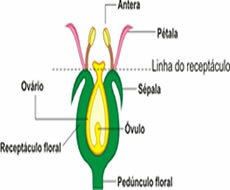In angiosperms, the elements related to sexual reproduction are found in flowers. In complete flowers there is a set of structures called floral whorls. One of the components of floral whorls is the gynoecium, a structure that constitutes the female reproductive system, formed by the pistil or carpel.
The pistil is characterized as the constituent structure of the gynoecium and is formed by one or more modified leaves, which fuse to form two parts:
The first part is a dilated portion, known as the ovary, which contains the egg in which the female gametophyte develops, which forms the oosphere.
The second part is an elongated portion, called a stylet, through which the sperm cells originated from the pollen will form the pollen tube, for the fertilization of the eggs located in the ovary.
The third part is known as the stigma, it is at the apex of the stylet and has the function of receiving the pollen.
Follow the image:

Did you notice that some types of gynoecosis do not have the stylet? Thus, the ovary is in direct contact with the stigma and inside the ovary there may be more than one egg, and each egg that is fertilized will give rise to a seed. So how many eggs are there in the avocado flower? And the watermelon?
The gynoecium can be formed by one or more pistils. Note that the structure represented by the letter D has only one pistil, while that of the letter B has several, being joined by the ovary.
Gyceans can be classified into groups according to the structure of the pistils, but they are basically grouped into monocarpelar or pluricarpelar.
The ovary can also take different places in relation to floral structures. When it is inside a protective structure, known as an urnula, inside the chalice, it is classified as an ovary. infer, however, when it is above other floral pieces, inside or outside the urnula, the ovary is classified as super.

Ovary Inferus Ovary Superus
The flower has some special modifications that allow to streamline plant reproduction and so favoring pollination, such as the occurrence of colored petals, odors and nectar to attract animals pollinators.
Fabricio Alves Ferreira
Graduated in Biology
Brazil School Team
Kingdom Plante - Realms of the Living World - Biology - Brazil School

